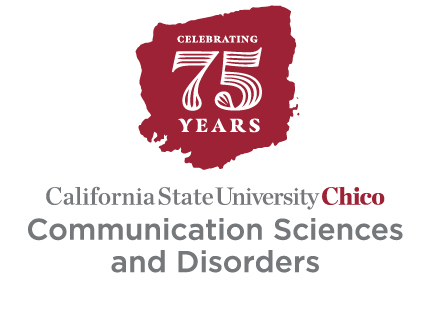CMSD Strategic Plan
Vision Statement
The CMSD program is envisioned to be an innovative program for developing the highest quality professionals, and to be a model clinical facility, providing speech and language service to underserved communities in Northern California.
Envisioned Future
From our vision statement, the CMSD program foresees the following to result from strategic planning in the next 10 years:
- A complement of six full time, tenure/tenure track faculty, with at least two part-time clinical instructors, and full time ASC dedicated to the program.
- Research opportunities for graduate students (joining faculty projects, theses, and conducing clinic-based single subject designs)
- Leading-edge clinical instrumentation, techniques, and specialty clinics/groups
- Interdisciplinary clinical experiences at the university and through relationships with allied professionals
- Multicultural opportunities through participation with the International Student program and community outreach centers
- Innovative sequenced curriculum
- CEU provider for speech-language pathologists in the California North state
Mission Statement
The mission of the Communication Sciences and Disorders (CMSD) program is to provide students with the knowledge and skills needed to enter the profession of speech-language pathology through an enriched, flexible, and innovative learning environment, both academically and clinically. The program strives to fosters critical thinking, evidence-based problem-solving, life-long learning, and consummate professionalism. To meet these ends, the program aims to employ expert, student-oriented faculty, and staff. We are dedicated to program growth and improvement. We strive to enhance associations with the university and local communities to provide greater interdisciplinary and collaborative clinical opportunities for our students, clients, and faculty. The CMSD program is committed to providing high quality clinical services to the North State Community.
Strategic Objectives
Based on the program goals of excellence in academic instruction and clinical education in speech-language pathology, the CMSD program is committed to the following objectives.
Objective 1
Promote and maintain a student learning environment that fosters intellectual curiosity, creative problem-solving, and use of research and technology in teaching and learning through an innovative, flexible curriculum with service learning and community service opportunities.
Objective 2
Promote the Teacher-Scholar model that encourages faculty to infuse experiential learning, evidence-based practice, and peer-reviewed research into the learning process; and to disseminate basic and applied research into the community via publications, presentations, and tutorials.
Objective 3
Prepare graduate students for professional licensure, certification, and credentialing, employment in any setting, and when appropriate, doctoral level training.
Objective 4
Promote the highest standards for academics and clinical training to meet standards for CFCC and maintain national accreditation through CAA- ASHA, regional accreditation through WASC, and state accreditation through CCTC.
Objective 5
Through the Center for Communication Disorders, provide quality service to the North state-at large, university, and K-12 communities, using technology, research, and excellence in clinical teaching, including currency in clinical knowledge and interdisciplinary approaches, through continued training of faculty and supervisors.
Objective 6
Foster diversity, equity, and inclusion through recruitment and retention of students from underrepresented populations.
Strategic Plan
The following areas were identified as barriers to attaining our vision and mission and meeting our program goals and strategic objectives and are based on CTC site visit team observations, employer surveys, internship supervisor feedback, Advisory Board feedback, PRAXIS results, student and alumni reports, exit interviews, and faculty report. Detailed below are strategies for attaining our objectives, the baselines for each strategy, indicators of success, and timelines. The corresponding Strategic Objective is listed next to the focus area.
Focus Areas 1 (Objective 6): Diversity, Equity, and Inclusion
Goal: In accordance with ASHA’s strategic goal of increasing diversity, equity, and inclusion (DEI) within the profession the CMSD program will focus on DEI by recruiting and maintaining a student population that is reflective of the diverse university population.
Issue: The diversity of our student population in inconsistent and is not always reflective of the larger University demographics.
Strategy: Knowing many graduate students come from our undergraduate program, the CMSD program will develop a recruitment and retention plan that focuses on diverse student populations.
- The program will collaborate with groups on campus that support underrepresented populations and begin recruitment at the freshman level.
- The program will participate in off-campus recruitment targeting rural high school communities that are often underserved.
- The Program will evaluate and modify our admission process as needed to support the recruitment of diverse students.
Focus Area 2 (Objective 4): Resilient, Innovative Curriculum
Goal: Assess our current academic and clinical curriculum to ensure that it meets or exceeds the standards of our various accreditors in a manner that is mindful of the student experience and program completion timeline.
Issue: The CMSD program responds to three major accreditors, CAA, WASC, and CTC. Each entity has their own set of standards and guidelines required to meet accreditation expectations. The program needs to ensure that our academic and clinical curriculum is designed in a way that meets new standards and expectations while considering the student experience and workload.
Strategy: Using Accreditation standards as our guide the program will:
- Evaluate our Course sequence to ensure all accreditation standards are addressed.
- Audit our course syllabi to ensure that course objectives align with accreditation standards.
- Evaluate course curriculum to ensure that it aligns with syllabi objectives.
Focus Area 3 (Objective 3): Graduate Cohort Size
Goal: Increase the annual number of students admitted into the MS program to 30.
Issue: The growth of our program is dependent on the recruitment of quality clinical placements. Establishing these placements takes time and manpower. The Program currently has an Internship Coordinator position for 3 units each fall and spring. This AWTU is not enough for new site exploration and recruitment.
Strategy: The program will:
- Fund an internship site exploration position.
- Establish 5 new student agreement contracts in the schools, 5 contracts in the medical setting, and 5 contracts in the private setting.
- Maintain new site relationships through periodic CI events/meetings.
- Increase the internship Coordinator position to cover summers.
Focus Area 4 (Objective 1): Interprofessional Collaborations
Goal: In Acknowledgement of ASHA’s efforts to increase IPE/IPP the CMSD program will explore university and community opportunities to engage our students in collaborative practices with other service professionals
Issue: Current IPE/IPP opportunities are available outside of the required curriculum. CMSD is a high unit major, and these outside opportunities are difficult for our students to engage in. We need to embed IPE/IPP opportunities into MS coursework.
Strategy: The program will:
- Explore campus and virtual IPE/IPP opportunities.
- Evaluate current curriculum and identify courses where IPE/IPP can be addressed.
- Consider simulations that facilitate interprofessional collaboration.
- Identify opportunities for interprofessional collaboration in clinical placements.
Evaluating the Strategic Plan
Progress in meeting focus area strategies will be evaluated each year by the CMSD faculty. Progress in meeting the plans’ objectives will be evaluated every other year by the faculty as a whole and the advisory board each spring. The Strategic Plan in its entirety will be evaluated every three years by the faculty or sooner based on any potential changes in the institution’s goals and strategic plan and/or changes in accreditation standards to ensure congruence.


